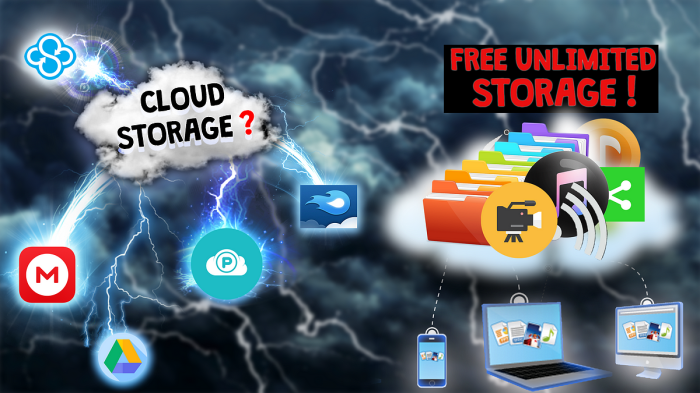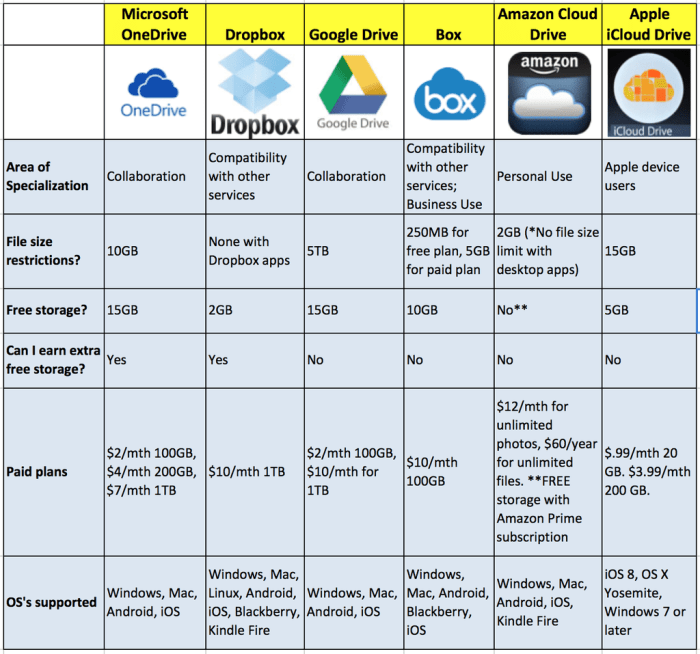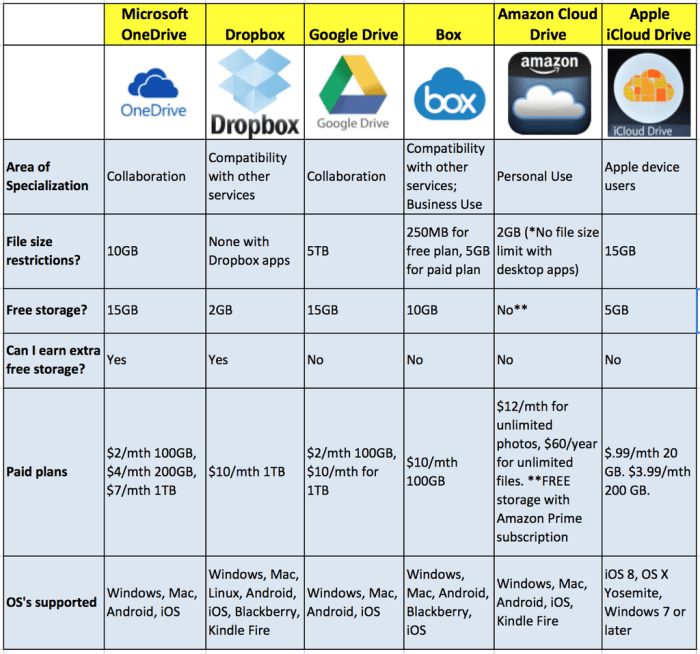Comparing cloud storage pricing which one saves you most – Comparing cloud storage pricing, which one saves you most? This guide delves into the complexities of cloud storage pricing models, exploring the various factors influencing costs, and ultimately helping you choose the most economical option. We’ll examine different pricing structures, from per-gigabyte to tiered models, and uncover the hidden costs often overlooked. Understanding these nuances is crucial before committing to a cloud storage provider.
We’ll also discuss how factors like storage type, data transfer, and frequency of retrieval can significantly impact your overall expense. Choosing the right cloud storage solution is a smart financial move.
This comprehensive analysis will cover popular cloud storage providers, examining their pricing models, storage capacity, features, and data transfer costs. We’ll also dissect specific use cases, such as backup and recovery, photo storage, and business data, to illustrate how these needs influence storage choices and pricing. The guide will then equip you with strategies to optimize cloud storage costs, including choosing appropriate storage classes, utilizing automated tools, and efficiently managing data transfer.
We’ll demonstrate how these strategies can lead to substantial savings, offering real-world examples of cost optimization.
Introduction to Cloud Storage Pricing Models
Cloud storage services offer various pricing models to cater to diverse needs and budgets. Understanding these models is crucial for making informed decisions when choosing a cloud storage provider. Choosing the right model directly impacts your overall cost and the flexibility of your storage solution. This section will delve into the common pricing models used in cloud storage, outlining their features, benefits, and practical calculation examples.
Common Cloud Storage Pricing Models
Cloud storage pricing models are designed to balance affordability and scalability. Different models cater to different needs, from occasional storage to large-scale data backups. Understanding these models is critical for aligning your storage needs with the right pricing structure.
- Per Gigabyte (GB) Pricing: This model charges a fixed price per unit of storage space. It’s straightforward and predictable, making it ideal for users who need a specific amount of storage capacity and don’t anticipate significant changes in their data volume. This is commonly seen with basic storage plans or for users needing a set amount of space for a project or a short period.
Examples include storing photos, documents, or backups of a fixed size.
- Per Month Pricing: This model charges a fixed price per month, regardless of the amount of data stored. This is a good choice for users who anticipate fluctuating storage needs or have a consistent need for a certain level of access and features. The pricing might include features like data transfer, access, or support, making it a more comprehensive package than per GB pricing.
For example, a monthly plan might include a certain number of data transfer credits, which will influence the total cost depending on the amount of data being transferred.
- Tiered Pricing: Tiered pricing structures offer varying storage costs based on the amount of data stored. This approach often provides economies of scale, where larger storage amounts come with lower per-gigabyte costs. This model is beneficial for businesses and users with high data volume needs, as it can help optimize costs over time. Typically, the higher tiers include additional features or faster access speeds, further justifying the higher cost.
Figuring out the best cloud storage deal can be tricky, right? Comparing prices and features is key to finding the most cost-effective option. But while you’re researching, have you considered protecting your Galaxy S20? Thinking about a screen protector for your phone might seem like a detour, but ultimately, a well-protected phone can save you money in the long run, just like a savvy cloud storage choice.
So, get back to comparing those cloud storage plans and find the one that’s right for you!
Pricing Model Comparison
The choice of pricing model is influenced by factors like storage requirements, data transfer needs, and anticipated future growth. This table compares the common pricing models, including examples of how they are calculated.
| Pricing Model | Description | Calculation Example | Suitable Use Cases |
|---|---|---|---|
| Per Gigabyte (GB) | Fixed price per unit of storage. | $0.01 per GB; 100 GB = $1.00 | Storing a fixed amount of data; backups, personal photos. |
| Per Month | Fixed price per month, regardless of storage used. | $10 per month for a basic plan; additional costs may apply for data transfer. | Users with fluctuating needs, regular data transfer requirements. |
| Tiered Pricing | Varying costs based on storage tiers. | Tier 1: $0.02/GB (up to 100GB); Tier 2: $0.015/GB (100GB – 500GB); Tier 3: $0.01/GB (500GB+). A user with 200GB would pay $3.00. | Businesses with significant data volumes; organizations anticipating future growth. |
Importance of Understanding Pricing Models
Choosing the right cloud storage pricing model is critical to avoiding unexpected costs and ensuring your storage solution aligns with your budget and future needs. A clear understanding of the model helps in predicting expenses and planning for potential data growth. It’s important to consider factors such as anticipated storage growth, data transfer needs, and potential future expansion when selecting a model.
Detailed analysis of each provider’s specific pricing tiers and associated features is essential for cost optimization.
Factors Affecting Cloud Storage Costs: Comparing Cloud Storage Pricing Which One Saves You Most
Cloud storage, while offering unparalleled accessibility and scalability, isn’t free. Understanding the factors influencing pricing is crucial for making informed decisions and optimizing your cloud storage strategy. Different storage providers employ various pricing models, and knowing the underlying drivers of those models empowers you to select the most cost-effective solution for your needs.Choosing the right cloud storage solution often boils down to a meticulous analysis of your specific data needs.
This involves considering several key variables, from the type of data you store to the frequency of access and the location of your data. This detailed analysis helps you tailor your storage strategy to fit your budget and requirements.
Storage Type
Different storage types cater to various data access patterns and performance needs, directly impacting cost. The most common storage types include block storage, object storage, and file storage. Block storage is optimized for high-performance applications requiring quick access to data, while object storage is better suited for large datasets and infrequent retrieval, and file storage provides a familiar file-system structure.
Each type has distinct performance characteristics and pricing structures.
- Block storage, frequently used for databases and virtual machines, typically offers high performance but often comes with a higher price tag due to its specialized hardware and features.
- Object storage, suitable for storing large amounts of unstructured data like images, videos, and logs, often boasts lower costs per gigabyte due to its scalability and efficiency in managing massive datasets.
- File storage, a more traditional approach, offers a familiar file system structure, and its pricing structure is often more straightforward, making it easier to estimate storage costs.
Data Transfer Costs
Data transfer costs, whether transferring data into or out of the cloud, can significantly impact your overall expenses. The distance between your location and the cloud data center plays a pivotal role in determining transfer costs. For instance, transferring data across continents will typically incur higher costs than transferring data within the same geographic region.
- Transferring data into the cloud, often associated with uploading new files or backing up existing data, involves transferring data from your on-premises environment to the cloud provider’s servers. The volume and speed of this transfer influence the costs.
- Transferring data out of the cloud, often associated with downloading data or retrieving backups, can also incur significant costs. Factors such as the amount of data retrieved and the frequency of retrieval are crucial in determining these expenses.
Retrieval Frequency
The frequency at which you access your data significantly impacts your cloud storage costs. Frequently accessed data stored in faster, more expensive storage tiers will generally cost more than infrequently accessed data stored in less expensive, slower storage tiers. Cloud providers offer tiered storage options, allowing you to categorize data based on access patterns and optimize costs.
- Frequent retrieval of data might necessitate storing it in high-performance storage, which commands a premium price. This is especially true for mission-critical applications or data that needs immediate access.
- Infrequent data retrieval can be handled with cheaper storage options. This approach is suitable for data that is not accessed regularly or for archival purposes.
Data Size
The amount of data you store directly correlates with your cloud storage costs. Larger datasets generally translate to higher storage expenses. Cloud providers often offer tiered pricing structures, where larger storage volumes can result in lower costs per unit of storage.
- Small storage needs might result in higher costs per gigabyte due to fixed costs associated with managing the storage infrastructure.
- Large storage needs can often be optimized with cloud storage solutions that offer bulk discounts, resulting in lower costs per gigabyte.
Data Location
The geographical location of your data center significantly impacts cloud storage costs. Storing data in a specific region might have lower transfer costs, potentially leading to lower overall expenses.
- Data stored in a data center closer to your location typically has lower transfer costs, which can translate to significant savings.
- Storing data in a data center located in a geographically distant region may result in higher transfer costs, impacting your overall cloud storage budget.
Cost Implications Table
| Factor | Potential Cost Implications |
|---|---|
| Storage Type | Block storage: high performance, high cost; Object storage: large datasets, low cost per GB; File storage: familiar interface, moderate cost. |
| Data Transfer | Transferring data across continents: high cost; Transferring within the same region: lower cost. |
| Retrieval Frequency | Frequent access: higher cost; Infrequent access: lower cost. |
| Data Size | Small size: higher cost per GB; Large size: lower cost per GB. |
| Data Location | Data center closer to location: lower transfer cost; Distant data center: higher transfer cost. |
Comparing Popular Cloud Storage Providers
Choosing the right cloud storage provider can be tricky, especially with the diverse pricing models and features available. Understanding how different providers structure their costs, storage capacity, and data transfer policies is crucial for making an informed decision. This comparison will analyze the pricing structures of three leading providers, highlighting their strengths and weaknesses.
Figuring out which cloud storage plan offers the best value can be tricky. With so many options, it’s hard to know where to start. Meanwhile, Google is upping its security game with Google Drive and YouTube, making them even more trustworthy for your data, especially important when considering google drive and youtube getting more secure. Ultimately, the best cloud storage choice depends on your needs and budget, so doing your research on pricing is key to finding the right fit.
Pricing Structures of Leading Cloud Storage Providers
Different cloud storage providers employ various pricing models, each with its own set of benefits and drawbacks. Factors like storage capacity, data transfer speeds, and specific features influence the overall cost. This section delves into the pricing structures of three prominent providers.
Storage Capacity and Features
Each cloud storage provider offers varying storage capacities and features. The choices available impact storage costs and the overall functionality of the storage solution. Understanding these differences is crucial when selecting a provider. Factors like the availability of backup and restore features, versioning, and data encryption are often crucial for business users.
Figuring out the best cloud storage deal can be tricky. With so many options, it’s tough to know which one will save you the most money. Meanwhile, it’s pretty amazing that the iPad has hit 500 million sales in its 10 year anniversary, check out this amazing milestone. But back to the savings: comparing various cloud storage plans and evaluating their features is key to finding the right fit for your needs and budget.
- Amazon S3: Amazon S3, a highly scalable storage service, offers a wide array of storage classes. These storage classes, including Standard, Intelligent-Tiering, and Glacier, cater to different needs and price points. Its comprehensive features, including data encryption, versioning, and robust security measures, make it a popular choice for businesses. The ability to customize storage classes dynamically is a key feature.
- Google Cloud Storage: Google Cloud Storage (GCS) provides a flexible storage solution with multiple storage classes, including Standard, Nearline, and Coldline. These classes offer different levels of accessibility and pricing. Features such as versioning and data encryption enhance security. The integration with other Google Cloud services is a significant advantage for many users.
- Microsoft Azure Blob Storage: Microsoft Azure Blob Storage is known for its scalability and reliability. It offers a variety of storage tiers with varying access frequencies and costs. Its integration with other Azure services and its global presence are crucial factors for businesses operating in multiple regions. Features like data encryption and server-side encryption are available for enhanced security.
Storage Tiers and Their Costs
Cloud storage providers typically offer various storage tiers to cater to different needs and budgets. These tiers are often categorized based on access frequency, performance requirements, and cost sensitivity. Understanding these tiers is essential to make an optimal selection for specific workloads.
- Amazon S3: Amazon S3’s storage classes like Standard, Intelligent-Tiering, and Glacier significantly impact costs. Standard is optimized for frequent access, while Glacier is for infrequent retrieval. The Intelligent-Tiering class dynamically adjusts storage costs based on access patterns. This adaptability is a key benefit.
- Google Cloud Storage: Google Cloud Storage offers tiered storage options with varying pricing based on access frequency. Standard is suitable for frequent access, while Nearline and Coldline are designed for less frequent access. The dynamic pricing adjustment based on storage usage is an advantage.
- Microsoft Azure Blob Storage: Azure Blob Storage’s tiered storage solutions are designed for different access needs. Hot, Cool, and Archive tiers are available, offering varying levels of performance and cost. The hot tier is designed for frequently accessed data, while the archive tier is for infrequently accessed data.
Data Transfer Costs
Data transfer costs are a crucial factor in the overall cloud storage expense. The transfer of data to and from the cloud storage service significantly impacts the final bill. Different providers may have different pricing models for inbound and outbound data transfer.
- Amazon S3: Data transfer costs in Amazon S3 depend on the source and destination. Transferring data within the Amazon network often incurs lower costs than transferring data from or to other networks. This consideration is crucial when designing storage strategies.
- Google Cloud Storage: Google Cloud Storage’s data transfer pricing is based on the volume and location of the transfer. Transfers between Google Cloud regions may have different pricing models compared to transfers to or from other networks.
- Microsoft Azure Blob Storage: Azure Blob Storage’s data transfer costs are determined by the volume and location of the data. Data transfer within the Azure network often incurs lower costs. This aspect is critical when planning cloud storage strategies.
Pricing Model Comparison
This table summarizes the pricing models of the three providers, highlighting key differences.
| Feature | Amazon S3 | Google Cloud Storage | Microsoft Azure Blob Storage |
|---|---|---|---|
| Storage Tier Options | Standard, Intelligent-Tiering, Glacier | Standard, Nearline, Coldline | Hot, Cool, Archive |
| Data Transfer Costs | Variable based on source/destination | Variable based on volume/location | Variable based on volume/location |
| Pricing Model | Pay-as-you-go, storage-based | Pay-as-you-go, storage-based | Pay-as-you-go, storage-based |
Analyzing Specific Use Cases and Costs

Understanding cloud storage costs requires looking beyond generic pricing tiers. Different use cases, like backing up critical business data or storing personal photos, have varying storage needs and access patterns. This impacts the overall cost-effectiveness of a particular provider. Choosing the right cloud storage solution depends on how you intend to use it.Analyzing the cost implications of specific use cases is crucial for making informed decisions.
Factors like frequency of access, data size, and expected growth play a significant role in determining the most economical cloud storage option. Understanding the cost breakdown for different use cases helps in selecting the appropriate storage type and provider.
Backup and Recovery, Comparing cloud storage pricing which one saves you most
Backup and recovery use cases necessitate high reliability and often involve large volumes of data. Data needs to be stored securely and be easily accessible for restoration in case of failures. Providers offer various backup solutions with varying degrees of automation and data protection features. These features can significantly influence the cost of storing data.
- Frequent backups of large datasets often require more frequent retrieval and restoration, which can translate into higher costs, especially for providers that charge per retrieval.
- Cloud storage providers often offer specialized backup solutions, including features like automated snapshots and continuous data protection, which can increase storage costs but offer greater data safety and lower recovery times.
- A business that backs up terabytes of data every week will incur significantly higher costs compared to a user who backs up a few gigabytes of personal data once a month. This highlights the direct correlation between data volume and costs.
Photo Storage
Personal photo storage is a common use case for cloud storage. High-resolution images and videos require significant storage space. Cost-effectiveness depends on the frequency of uploads and the desired storage duration.
- Users who frequently upload large photo collections will incur higher costs than those who upload occasionally. The frequency of uploads is a critical factor influencing the overall expenditure.
- Storage costs for photos vary considerably depending on the storage tier selected and the provider. For instance, a user storing high-resolution photos might opt for a higher-capacity tier with potentially lower per-gigabyte pricing.
- Archiving old photos or photos with low usage frequency might be more cost-effective in lower-tier storage options, provided the retrieval frequency is low.
Video Storage
Video storage requires substantial storage capacity, and costs are heavily influenced by the resolution and duration of the videos. High-definition (HD) and 4K videos demand more storage space and processing power. Considerations include storage tier and potential transcoding requirements.
- Cloud storage providers typically offer different storage classes for various video formats and resolutions. Users may choose storage classes based on expected usage patterns and frequency of access.
- Video editing and transcoding services may be an additional cost. If a user needs to process videos or convert them to different formats, they should factor in the additional costs for those services.
- Providers with tiered storage options allow users to store different quality videos at different costs. A user may store lower-quality videos in less expensive storage tiers, saving money while maintaining access to the videos.
Business Data Storage
Business data storage often involves sensitive information and compliance requirements. Data security and regulatory compliance are crucial factors in the decision-making process. Storage costs are often dependent on data encryption, access controls, and compliance standards.
- Businesses require robust security features and access controls for data protection. The level of security and compliance features offered by the cloud storage provider can influence the cost.
- Storage providers offering data encryption and access controls may charge extra for these advanced features.
- Specific industry regulations, such as HIPAA or GDPR, may dictate the type of storage needed and the required security measures, impacting the total cost of business data storage.
Comparative Costs (Example)
The following table illustrates approximate cost implications for different use cases with hypothetical providers. Actual costs may vary significantly based on specific storage tiers and usage patterns.
| Use Case | Provider A | Provider B | Provider C |
|---|---|---|---|
| Backup (1TB) | $50/year | $75/year | $40/year |
| Photo Storage (100GB) | $20/year | $15/year | $25/year |
| Video Storage (100GB HD) | $40/year | $30/year | $50/year |
| Business Data (10TB) | $1000/year | $1200/year | $800/year |
Methods for Cost Optimization
Saving money on cloud storage doesn’t have to be a guessing game. By understanding the nuances of different storage classes and implementing smart strategies, you can significantly reduce your cloud storage expenses without sacrificing performance or functionality. This section dives into practical methods for optimizing your cloud storage costs, empowering you to make informed decisions and maximize your cloud investment.Cloud storage costs can vary dramatically depending on the chosen storage class, data transfer patterns, and the frequency of access.
Implementing cost-optimization strategies is crucial for maintaining a healthy cloud budget, ensuring optimal value for your investment.
Choosing Appropriate Storage Classes
Different storage classes cater to varying access frequencies and data retention needs. Understanding these differences is key to minimizing costs. Cold storage, for example, is designed for infrequently accessed data and offers significantly lower costs compared to hot storage, which is optimized for frequently accessed data. Archiving data to cold storage when it’s no longer needed for immediate use can drastically reduce storage costs.
Analyzing your data access patterns is essential to determine the most suitable storage class for each dataset.
Leveraging Automated Tools
Cloud providers offer a range of automated tools to optimize storage costs. These tools can automatically move data between storage classes based on access patterns, further optimizing your spending. For example, some providers offer tools that automatically move data to cold storage after a certain period of inactivity, enabling cost savings on infrequently used files. Taking advantage of these automated tools can significantly reduce manual effort and ensure continuous cost optimization.
Managing Data Transfer Efficiently
Data transfer costs can quickly add up, especially when dealing with large datasets. Careful planning and management of data transfer are crucial to optimize storage costs. Optimizing network configurations and strategically placing data closer to users can reduce transfer costs. Using transfer acceleration services provided by cloud providers can also reduce transfer times and associated costs. Implementing these strategies can significantly impact overall cloud storage costs.
Data Compression and Archival Storage
Data compression significantly reduces the amount of storage space required for data, directly impacting storage costs. Compression algorithms reduce file sizes without compromising data integrity. Compressing data before storing it in the cloud can significantly reduce storage costs. Archival storage solutions, designed for long-term data retention, offer extremely low-cost storage options for infrequently accessed data. Combining compression and archival storage can deliver substantial cost savings, especially for historical or infrequently used data.
Actionable Steps to Optimize Storage Costs
- Analyze data access patterns: Identify which data is frequently accessed and which is infrequently accessed. This analysis will help you determine the most suitable storage class for each dataset. Properly analyzing data access frequency is crucial for optimizing storage costs and ensuring appropriate storage class allocation.
- Implement data compression: Compress data before uploading it to the cloud to reduce storage space requirements. This simple step can lead to significant cost savings, particularly for large datasets.
- Utilize automated tools: Take advantage of cloud provider tools to automatically move data between storage classes based on access patterns. This approach minimizes manual effort and ensures consistent cost optimization.
- Optimize data transfer: Minimize data transfer costs by strategically placing data closer to users and using transfer acceleration services.
- Evaluate archival storage options: Consider archival storage for long-term data retention. This option can significantly reduce costs for data that is infrequently accessed.
- Regularly monitor and review: Continuously monitor your storage costs and make adjustments to your storage strategy as needed. This ensures that your cloud storage costs remain optimized and aligned with your current needs.
Illustrative Examples of Cost Savings

Cloud storage, while convenient, can quickly become expensive if not managed effectively. This section dives into practical examples demonstrating how different users can optimize their cloud storage costs and save significant amounts of money through smart data management strategies. We’ll see how various approaches to data handling affect the bottom line, and examine real-world cases of successful cost optimization.
Data Compression and Archiving
Implementing data compression and archiving strategies is crucial for minimizing storage costs. By reducing the size of data stored, users can significantly decrease their overall cloud storage footprint. For example, a company storing large video archives can reduce their storage needs by 50-70% by using lossless compression techniques. This translates to substantial savings, especially for organizations with massive datasets.
Archiving infrequently accessed data to cheaper storage tiers further reduces costs. Imagine a marketing firm archiving old campaign data. By moving it to a less expensive, slower storage tier, they can significantly reduce their monthly cloud storage bill without sacrificing access when needed.
Intelligent Tiering and Lifecycle Management
Smartly moving data between storage tiers is a powerful cost-saving technique. This involves categorizing data based on access frequency and storing it in the most cost-effective tier. For instance, a photo-sharing platform could categorize user photos into active, recently accessed, and archived. Active photos would remain in a high-speed, high-cost tier. Photos not accessed in the past month would transition to a less expensive, slower tier.
Frequently accessed user photos would remain in a faster, more expensive tier, while infrequently accessed photos would be moved to an economical tier. This method optimizes storage costs without impacting user experience.
Data Deletion and Retention Policies
Establishing clear data deletion and retention policies can lead to substantial cost savings. Many cloud providers offer various retention policies. A small business could set policies for deleting customer data after two years unless renewed. This proactive approach prevents unnecessary storage costs and ensures compliance. For instance, a news organization might have policies that archive articles for 1 year before permanently deleting them.
By establishing these policies, the organization ensures compliance while keeping storage costs under control.
Choosing the Right Cloud Storage Provider and Plan
The specific cloud storage provider and the chosen plan can significantly affect costs. Different providers offer varying pricing structures, and users must understand these structures to optimize their storage costs. A user storing personal photos may find a provider offering a tiered pricing system more cost-effective than a provider with a flat rate. This example highlights the importance of evaluating different providers based on storage needs and usage patterns.
Real-World Case Study: Successful Cost Optimization
A global e-commerce company, utilizing a cloud storage service, recognized that their storage costs were rising. They implemented intelligent tiering by moving infrequently accessed product images to a cheaper tier. They also utilized data compression and archival, reducing their storage needs by 30%. These cost-optimization strategies reduced their annual cloud storage expenditure by 15%, significantly improving their bottom line.
Evaluating Storage Options for Specific Needs
Choosing the right cloud storage solution depends heavily on your specific needs. Simply picking the cheapest option isn’t always the best strategy. Understanding your data’s characteristics, how you intend to use it, and any regulatory constraints are crucial for making an informed decision. This section dives into tailoring storage choices to match particular requirements.
Identifying Specific Needs
Different types of data and workflows necessitate different storage approaches. Large-scale datasets demand high-capacity storage solutions, while real-time access applications require low-latency options. Compliance regulations, such as GDPR or HIPAA, may dictate specific security and accessibility protocols, influencing your selection process. Understanding these specific needs is the cornerstone of an effective storage strategy.
Impact on Storage Options and Pricing
The chosen storage option significantly affects the pricing model. For example, archiving infrequently accessed data in cold storage can drastically reduce costs compared to keeping it in hot storage. Real-time data access needs often translate to higher costs due to the premium placed on speed and availability. Compliance requirements, too, can add complexity and associated costs. Careful consideration of these factors is paramount for optimized cost management.
Analyzing Best Storage Options and Providers
Several storage options cater to various needs. Object storage, suitable for large-scale unstructured data, is often a cost-effective solution for archiving and backup. Block storage is better for applications demanding high I/O performance, like databases or file systems. File storage is often the most straightforward option for simple file sharing and collaboration. Cloud providers like AWS, Azure, and Google Cloud offer distinct storage services with varying pricing structures.
The optimal choice depends on your specific use case.
Table of Storage Options for Different Needs
| Need | Storage Option | Cloud Provider Example | Potential Cost Impact |
|---|---|---|---|
| Large-scale data archiving | Object storage | AWS S3 Glacier | Low ongoing costs, high initial cost if not optimized. |
| Real-time data access | Block storage | Azure Blob Storage | High ongoing costs due to high performance demands. |
| Compliance-sensitive data | Encrypted object storage | Google Cloud Storage (with encryption) | Higher costs due to security measures. |
| Simple file sharing | File storage | AWS S3 | Moderate ongoing costs; costs vary based on file size and access frequency. |
This table provides a high-level overview. Specific pricing varies significantly based on storage size, frequency of access, and the chosen cloud provider’s specific pricing model.
Wrap-Up
In conclusion, choosing the right cloud storage solution involves a careful consideration of pricing models, provider specifics, and individual use cases. This guide has illuminated the factors influencing cloud storage costs, enabling you to make informed decisions. By understanding the various pricing models, evaluating provider offerings, and optimizing your storage strategy, you can significantly reduce cloud storage expenses. Remember to consider your specific needs and priorities when selecting a provider and storage type.
By following the strategies Artikeld in this guide, you’ll be well-positioned to find the most cost-effective cloud storage solution for your needs.




